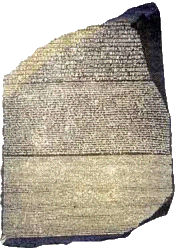
Also spelled stela. The plural form can be stelae or steles.
(pr. stee'lee)
Examples:

Egypt, probably from Abydos, Stela of Mentuwoser, c. 1955 BCE,
Dynasty 12, reign of Senwosret I, year 17, Middle Kingdom, painted
limestone, 19 5/8 x 41
inches (49.8 x 104.1 cm), Metropolitan Museum of Art, NY.

Egypt, Stele of the Royal Scribe Ipi, mid-14th
century BCE,
limestone, mineral paint,
95 x 71 cm, Hermitage Museum, St. Petersburg, Russia. In the
scene at the center of the stele, Ipi, a royal scribe, worships
the god Anubis. Anubis, shown with a canine head, was god of
the deceased.

Assyrian, Stele of Zincirli, 7th century BCE,
height 3.46 m, Near-Eastern
Museum, Berlin. See Mesopotamian art.

Greece, Attic, Grave stele of a youth and a little girl with
finial in the form of a sphinx, c. 530 BCE,
Archaic, marble,
height 13 feet 10 11/16
inches (423.4 cm), Metropolitan Museum of Art, NY. See finial
and Greek art.

Greece, Grave stele of a little girl, c. 450-440
BCE,
Parian marble,
height 31 1/2 inches (80.01
cm), Metropolitan Museum of Art, NY.
![]()
Greece, Athens, about 400 BCE,
Grave Stele, marble, 40.4 x 17 x 6 inches (102.5
x 43.25 x 15.25 cm), J. Paul Getty Museum, Malibu, CA.
![]()
Greece, Athens, Grave Stele of an Old Man, late 4th century
BCE,
pentelic marble,
Worcester Art Museum, MA.

Egypt, Magical Stela, 360-43 BCE,
Dynasty 30, reign of Nectanebo II, late Dynastic period, greywacke,
height 32 7/8 inches (83.5
cm), Metropolitan Museum of Art, NY. See Egyptian art.

Egypt, 203 BCE, Rosetta Stone, a slab of granite, 3 feet 9 inches x 2 feet 4 inches wide x 11 inches thick (118 x 77cm), the remains of a stele inscribed in three scripts: hieroglyphic, later Egyptian demotic — a cursive form of ancient Egyptian, and ancient Greek. Each of these three scripts were being used in Egypt at the time it was carved. An officer of Napoleon's engineering corps found the stone half buried in the mud near Rosetta, a city near Alexandria, in 1799. Carved on the stone is a decree by Egyptian priests to commemorate the crowning of Ptolemy V Epiphanes, king of Egypt from 203 - 181 BCE The Stone is an icon of script and decipherment.
Also see column, megalith, monolith, and obelisk.
https://inform.quest/_art